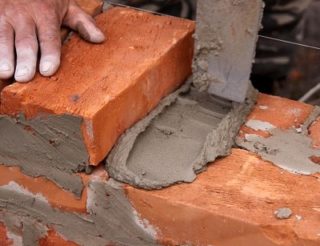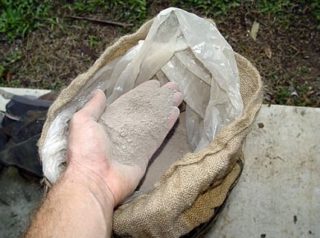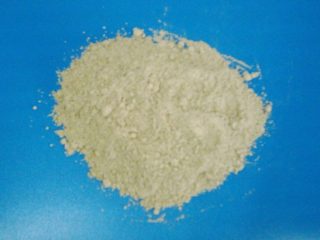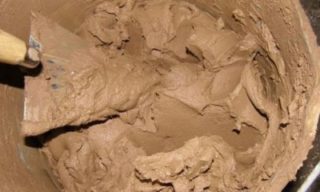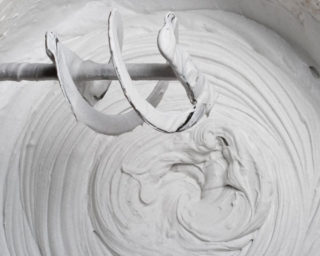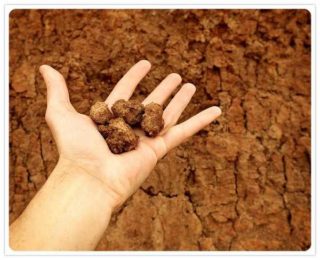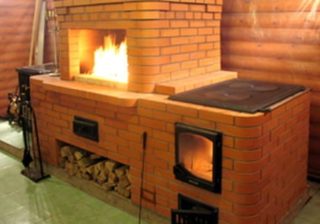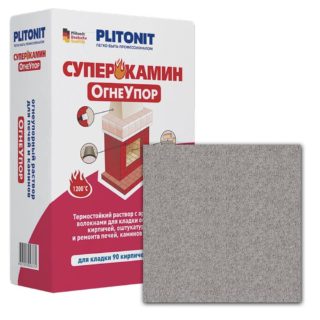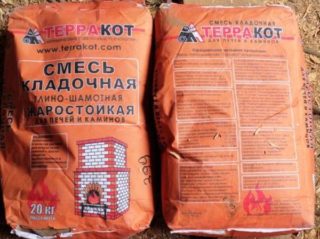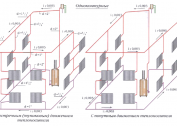During the construction of fire hazardous fireplaces and stoves, special solutions are used in the process of lining them. The furnace mixture is selected according to the type and material of the heating structure. Good quality material provides reliable surface adhesion, has heat-resistant characteristics and is easy to apply. Manufacturers produce finished products that need to be mixed on their own.
Types of mixtures for laying fireplaces and stoves
Fireplace and stove structures are built of natural stone or refractory bricks. To impart a monolithic structure, various compositions are used. They are suitable for outdoor masonry, the construction of a furnace and chimney, pouring the foundation, cladding and creating heat-resistant elements.
According to the type of resistance to high temperature and fire exposure, you can choose a masonry furnace mixture:
- heat-resistant - preserves the integrity and load-bearing strength of the structure at high temperatures;
- heat-resistant - protects the structural integrity of the masonry when exposed to fire and mechanical force;
- refractory - a property of viscous products that are resistant to fire and the effects of combustion products.
The composition and proportions depend on the type of furnace element.
Heat Resistant Mixtures
The material is able to withstand heat, maintain the load-bearing capacity of the structure and not be deformed from high temperature exposure. The standard mixture for casting a monolithic firebox or erecting a frame is made on the basis of:
- 1 part Portland cement grade M400-M600;
- 2 parts of ceramic crushed stone M150;
- 2 parts of fine quartz sand with fractions of 1 mm;
- 3/10 parts of fireclay sand;
- water in an amount of 4 liters per 10 kg of the mixture.
Purchased and self-prepared solutions are mixed in a concrete mixer - all ingredients are added gradually.
Finished materials are cleaned of organics, which eliminates the emission of carbon monoxide during operation of the furnace.
Fireclay compounds
A mixture based on refined clay and quartz sand crushed to a state of grain is characterized by:
- fire resistance depending on the manufacturer - from 1550 to 1850 degrees;
- average fraction size from 2 mm
- moisture absorption - 2-10% in high-burnt fireclay, about 25% in low-burnt fireclay.
Fireclay product is delivered in packages of 20 kg of weight, which is enough for laying 20-30 bricks. The construction of the chimney and furnace is made of clay-chamotte mixture in the proportions of 1: 1. Water will need ¼ part.
On a note! Refractory clay is used for cladding, but only 4 weeks after the first fireplace insert.
Dry pouring powder
Fire-resistant material based on cement aluminate and fireclay clay with fractions of 0.5 mm is used for pouring and repairing the internal parts of stoves, grills and a fireplace. Available in the form of a gray powder, scattered in bags of 25 kg. It has the following properties:
- permissible minimum pouring temperature - +5 degrees;
- solidification time - in 1 hour;
- the yield of the finished mass is from 11 to 12 l from the bag of 25 kg;
- resistance to temperature influence to +1300 degrees.
The solution is mixed in a concrete mixer. From the bag you need to gradually add from 2.5 to 3.5 liters of water.Large parts of the stove are poured with a layer of 50 mm, the arch - with a layer of 100 mm.
The refractory mass cannot be reinforced - its thermal expansion is less than that of metal.
Characteristics of furnace mixtures
Quality mixtures for stoves and fireplaces should have the following characteristics:
- limit of heating from 1300 to 1780 degrees - heat-resistant material does not crack when exposed to high temperature;
- density in the finished form from 1000 to 1800 kg / m3 - allows you to form a durable layer with high thermal conductivity;
- frost resistance - an indicator of up to 70 freezing and thawing cycles allows for external and internal construction;
- heat resistance, strength and ductile - properties increase the duration of the furnace;
- ecological cleanliness - materials without volatile impurities and chemicals do not emit carbon monoxide in the fireplace combustion process;
- combustibility class - a heat-resistant product is classified as NG (non-combustible);
- vapor permeability - from 0.09 mg / m * h * Pa - prevents joint moldiness.
A good composition during operation easily adheres to the surface, differs in its plastic structure and ease of application.
Advantages and disadvantages
For the laying of stoves and fireplaces, a high-temperature mixture is used, which includes clay, sand, lime or cement, heat-resistant ingredients. To obtain a homogeneous mass, water must be added to the material. Using finished products has several advantages:
- ease of mixing components;
- ready-made compounding, ensuring the strength of the composition;
- universality of use - suitable for cladding, masonry of external and internal parts;
- the attractiveness and evenness of the masonry seam;
- the presence of complete instructions with the rules of work and mixing;
- ease of application and the absence of seam fracture risks.
The use of building materials is associated with some difficulties. The mass is kneaded only with a mixer or in a concrete mixer, it solidifies quickly, therefore it is prepared in batches.
The choice of mixtures for the structural elements of the furnace
To choose masonry materials, it must be borne in mind that the stove consists of several elements:
- Foundation pillow - a monolithic element, built separately from the foundation of the house.
- The base of the furnace is not exposed to temperature stress, so it is built from red solid brick. For masonry, lime or lime-cement mortar is suitable.
- Fire blind area - represented by asbestos sheet or mineral cardboard, on which there is an iron sheet and felt with clay impregnation.
- The massif of the furnace - due to the increased effect of hot flue gas on the structure, it is built of ceramic brick with clay mortar.
- The furnace is very hot, therefore, it looks like a monolith in a clay-chamotte solution of a refractory type.
- The beginning of the chimney - it is heated to +400 degrees, which provides for laying on a mixture with a clay base.
- An otter, or fluff, is an element connecting the chimney and the ceiling. The temperature and aggressive effect on it is minimal, so the lime composition is suitable for standard bricks.
- Fireproof cutting - a heat-insulating metal box for which a solution is not needed.
- Chimney and fluff - are exposed to wind loads, chemicals. Mounted with a red solution.
The right choice of solution will save 10-12% of the money on the purchase of consumables.
Lime mixture
The refractory mixture for furnaces consists of sand, lime dough (1 part quicklime + 3 parts water). For self-cooking, you will need to sift the sand, mix it with the dough in a ratio of 1: 3 and add water to the density of sour cream.
The heat resistance of the product is from 450 to 500 degrees, but it is non-hygroscopic. The tool is used on the street, for processing part of the pipe protruding above the roofing. Due to the toxicity and duration of the cramp, calcareous materials are best used outdoors.
To increase strength, cement can be added to the lime product, and gypsum to accelerate adhesion.
Cement mixture
They are divided into three types:
- Cement - preparation requires water, cement and sand. Great strength and low gas density allow the use of compounds for the construction of the foundation.
- Cement-clay - durable solutions with which the thermal part of the fireplace and the beginning of the chimney are laid out.
- Cement-lime - mixtures are strong, but differ in low gas density. Suitable for the construction of fireplaces, foundations, chimneys.
For self-production, you will need to mix 1 portion of cement with 1-3 servings of additives and 6-15 servings of sand.
Strengthen the heat resistance of the cement mass with Portland cement and broken brick.
Clay mixture
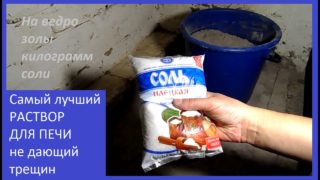 The material is suitable for the construction of a stove. Ideal mixture - does not crumble, has a homogeneous structure without lumps and the consistency of sour cream. Factory materials are made on the basis of:
The material is suitable for the construction of a stove. Ideal mixture - does not crumble, has a homogeneous structure without lumps and the consistency of sour cream. Factory materials are made on the basis of:
- white clay - increases the fire resistance of the mass, suitable for the construction of wood-burning stoves with heating the furnace to 1000 degrees;
- fireclay clay is a universal product that ensures the strength of the furnace structure at any temperature.
In order to increase strength, you can add to the solution:
- sodium chloride or sodium chloride - 100-150 g are needed per 1 bucket;
- Portland cement - for 1 bucket you will need from 500 g to 1 kg of product.
The consumption of clay mixture per 100 bricks is 25 liters.
Proportioning and solution checking
The amount of ingredients depends on the location and purpose of the kiln structure. To build a structure in the house you will need:
- 1 part sand + 1.5 parts clay;
- 3 parts of sand + 1 part of lime dough;
- 1 part of cement + 8-10 parts of sand + 2 parts of lime dough;
- a heat-resistant mass for a monolithic furnace is prepared on the basis of 1 part of portlet cement M400, 2 parts of broken brick, 0.3 parts of fireclay sand;
- refractory concrete can be made by mixing 20 kg of the finished composition with 8 l of water.
A brick sauna stove is built on the following solutions:
- cement - 1 part of cement + 3 parts of sand;
- lime - sand and lime are correlated as 2: 1;
- lime-cement - you need 2 parts of lime, 1 part of sand, from 6 to 16 parts of cement.
The firebox is laid out using clay-chamotte mass. For plastering, asbestos + lime + sand + gypsum, clay + asbestos + sand or clay + cement + sand + asbestos are used.
For outdoor structures, it is better to use a moisture-resistant composition based on 3 parts of sand and 1 part of cement.
Mixture testing
The quality of the lime dough is checked with a wooden lath. During mixing, the type of mass is determined:
- there is no material on the bar - a lean solution, adjusted by the addition of lime;
- lumps or film remain on the rail - the product is suitable for work;
- there is a thick dense layer on the plate - a greasy mass, in which it is worth adding a little sand.
Before using the clay solution, fat content is tested. It will be necessary to dilute with water 2 kg of clay, mix with a wooden stick and examine it:
- clay has stuck to the rail - a greasy remedy, digested by sand;
- small pieces stuck to the shoulder blade - you can start laying;
- there was a film on the bar - the skinny material, you need to adjust it with greasy clay.
Salt or plasticizers may be added to adhesion improvers.
Options for mixing the mortar
It is advisable to consider the technology of mixing the solution for the furnace using the example of slip clay. Practitioners use several methods of mixing.
Wet option
Clay dissolves in water, the finished mass is brought to the consistency of jelly. The dough is left for several days so that the lumps are stratified, and the inclusions sink to the bottom of the container. Then the slip with water is poured into another container and defended until completely dissolved. When a clear boundary is visible between clay and water, the liquid is drained.
Dry option
Eliminates the time spent on slipping clay. Kneading is carried out by filling a small layer of clay into a trough with small sides. Dry sand is poured over the material. The components are mixed with a hoe - they make a “cutting” or “weeding” in 5-6 approaches until the large lumps are completely crushed. To prepare the solution, you will need to add water in small portions.
Mixing times can be shortened with electric clay. It is used only on clay of medium-fat, low-fat and medium-soluble type.
Application features
In the case of self-preparation of the solution, several rules must be taken into account:
- For the construction of the furnace massif, it is worth increasing the heat resistance of the material.
- With a joint thickness of 3 mm, for every 90 bricks you need 25 kg of mortar.
- Fatty clay after drying lose strength and crack.
- In order to increase the strength of medium-fat clay, cement can be added to the mass.
- It is possible to accelerate the drying of the masonry if lime is added to the solution.
- The volume of building material is checked after the final batch.
- For each day of work, a new portion of the mixture is prepared.
When working with ready-made tools, they are guided by the manufacturer's recommendations. The materials are accompanied by instructions with specific tips for use:
- Water is added to the contents of the bag.
- The ingredients are mixed with a drill with a mixer nozzle at the rate of 1 hour of use.
- After solidification, the mixture does not work again.
- The masonry of the heating structure is carried out at a temperature of +10 degrees.
- To prevent cracking of the seam, it is necessary to purchase materials with plasticizers.
- The first heating is not carried out for 3 days after masonry.
- Lining is carried out 20-30 days after the furnace is put into operation.
- The efflorescence on the seam is removed with a damp cloth.
The effectiveness of ready-made solutions is better than home-made, but they are more expensive. For this reason, it is worth studying the products of different brands.
Manufacturers of prefabricated kilns
Russian consumers can purchase compositions of domestic and foreign production. The market includes heat-resistant, refractory and standard masonry materials.
Plitonit
Domestic brand that produces kiln solutions using German technologies. Popular products include:
- Thermal masonry. An economical tool for repairing and laying the exterior of fireplaces and stoves;
- Refractory. A mixture with reinforcing components, used for the construction of a combustion chamber made of heat-resistant brick;
- Hot melt adhesive. The adhesive material on which the ceramic tiles sit. Glue is also used as plaster.
The proportions for mixing are indicated in the instructions, depending on the type of composition.
Stove
Refractory mixture for masonry Pechnik is made on the basis of clay and cement ingredients. It has high water repellency, provides durability of the hitch. The peculiarity of the masonry mixture Pechnik - heat-resistant products withstands heating up to +1350 degrees. The advantages of the material include heat resistance, ease of use and reliability of the seam.Cons are high consumption due to fast setting.
Bossnab
Russian products based on red clay and quartz sand can mask the seam. Mixtures are produced by Nevsky Terminal SPb in two series:
- Budget. Inexpensive compositions in the form of a mix of red clay and sand. Materials are suitable for interior work and are characterized by low consumption - 25 kg is enough for 90 bricks;
- Premium They are characterized by resistance to temperature fluctuations. Plasticizers and lignosulfates in the composition allow for masonry on the street.
Budget solutions are characterized by heat resistance of +500 degrees, premium solutions - of +1100 degrees.
Terracotta
Heat-resistant products are made from kaolin clay, fireclay and sand, environmentally friendly. Plastic solution allows you to form a durable seam that can withstand heat up to 1300 degrees. The masonry line is homogeneous, the composition is easy to apply. The manufacturer recommends sifting material to remove large grains of sand and working with soaked brick.
With independent construction of the furnace, it is necessary to choose the right materials. Ready-made factory mixtures eliminate the time spent on the preparation of the solution and preparation of the ingredients.
